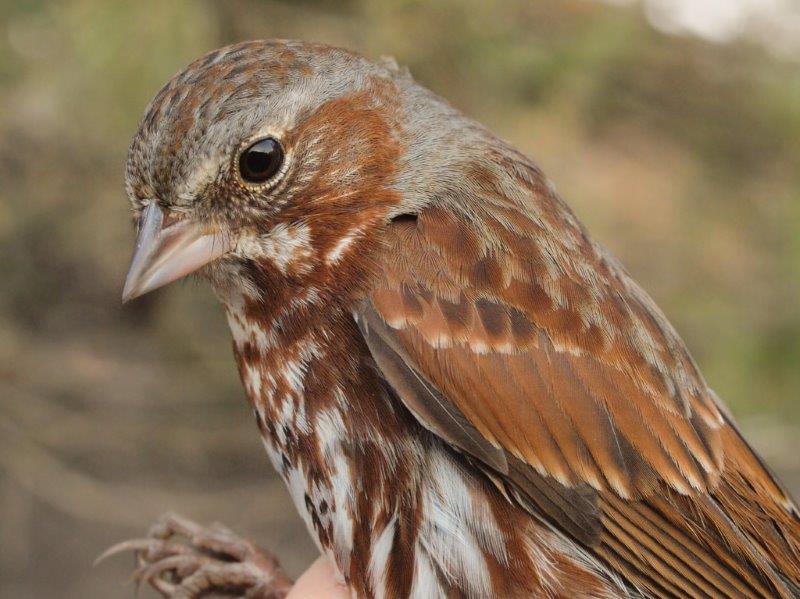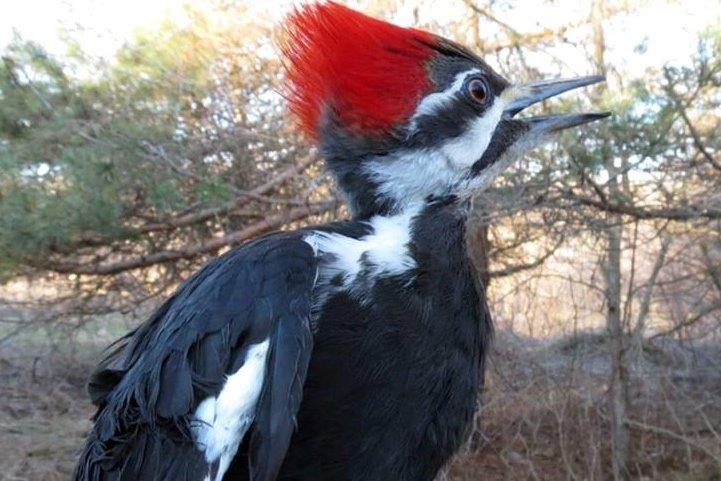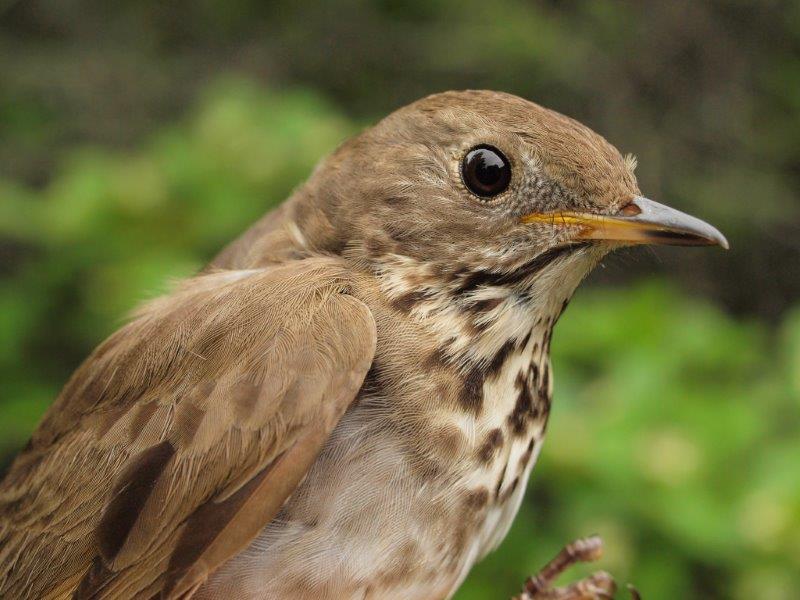Week 1
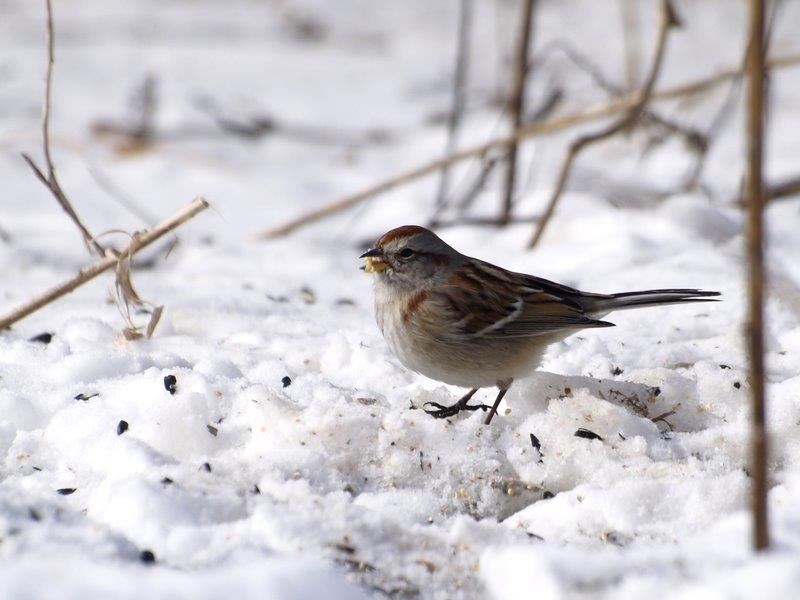
Conditions remain winter-like at MBO, with this American Tree Sparrow among many birds foraging for seeds on the bed of remaining snow (Photo by Simon Duval)
| THIS WEEK | THIS SPRING | 2015 TOTAL | SITE TOTAL | |
|---|---|---|---|---|
| # birds (and species) banded | — | — | 202 (11) | 52333 (114) |
| # birds (and species) repeat | — | — | 32 (6) | 10542 (70) |
| # birds (and species) return | — | — | 15 (5) | 1669 (38) |
| # species observed | 34 | 34 | 37 | 209 |
| # net hours | — | — | 35 | 89617 |
| # birds banded / 100 net hours | — | — | 577.1 | 58.4 |
Observers: Simon Duval, Gay Gruner, Lisa Keelty, Barbara MacDuff, Betsy McFarlane, Elise Titman, Rodger Titman
Notes: McGill Bird Observatory’s 11th Spring Migration Monitoring Program kicked off this week, even though it looked more like winter than spring – never before have we had so much snow remaining on site at this time of year! Nevertheless, the 34 species observed this week is close to the long-term mean of 35 for the first week of spring. However, it is worth noting that the count includes lingering winter birds such as Northern Shrike, as well as both Common and Hoary Redpoll, while some typically early arrivals such as Eastern Phoebe and Song Sparrow were not yet detected.
| # individuals banded | mean # individuals observed daily |
|---|---|
| — | 1. Canada Goose (60) |
| — | 2. Common Redpoll (22) |
| — | 3. Red-winged Blackbird (17) |
| — | 4. Black-capped Chickadee (13) |
| — | 5. American Crow (8) |
| — | 6. Northern Cardinal (7) |
| — | 7. Blue Jay (6) |
| — | 8. American Robin (6) |
| — | 9. Ring-billed Gull (4) |
| — | 10. Slate-colored Junco (4) |
Canada Goose was the most abundant species during the first week of spring, as it has been every year except 2008, when the mean daily count was a remarkably low 3 individuals. For the second time in the past three years, Common Redpoll was dominant as spring began, this time ranking as the most abundant songbird for the week (in 2013 the mean daily count of 23 was almost the same, but there were more Red-winged Blackbirds, whereas this year they were in third place). The (presumably mostly) resident Black-capped Chickadees were in fourth place to start off spring for the fourth year in a row. The remaining species in the top ten were all observed in relatively modest numbers (mean daily count less than ten), and comprised a fairly typical mix of local residents (American Crow and Northern Cardinal) and early spring migrants (Blue Jay, American Robin, Ring-billed Gull, Slate-colored Junco).
Week 2
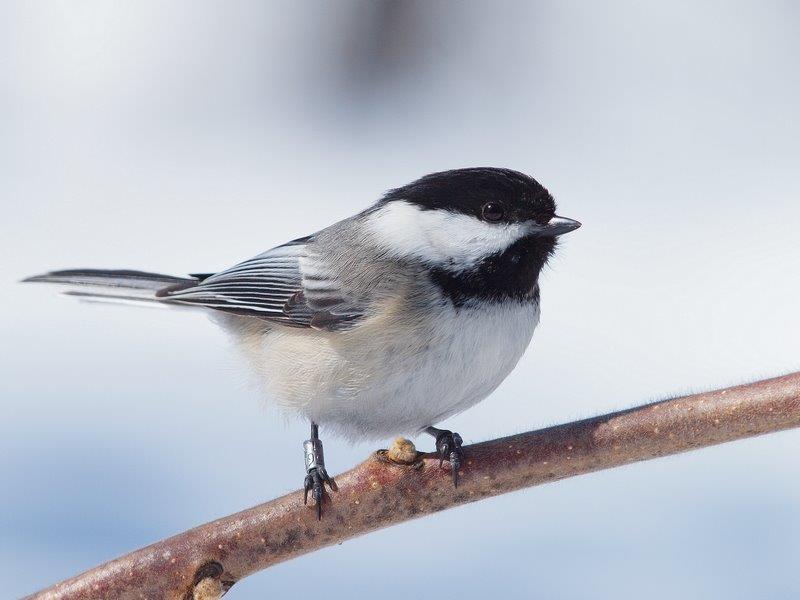
While we wait for spring weather to finally arrive, the resident Black-capped Chickadees are keeping our census observers company on their daily rounds (Photo by Simon Duval)
| THIS WEEK | THIS SPRING | 2015 TOTAL | SITE TOTAL | |
|---|---|---|---|---|
| # birds (and species) banded | — | — | 202 (11) | 52333 (114) |
| # birds (and species) repeat | — | — | 32 (6) | 10542 (70) |
| # birds (and species) return | — | — | 15 (5) | 1669 (38) |
| # species observed | 33 | 40 | 41 | 209 |
| # net hours | — | — | 35 | 89617 |
| # birds banded / 100 net hours | — | — | 577.1 | 58.4 |
Observers: Sue Bishop, Simon Duval, Gay Gruner, Lisa Keelty, Barbara MacDuff, Betsy McFarlane, Ahmad Shah
Notes: It remained unseasonally cold this week, and the count of species observed this week actually dropped by one compared to last week. However, six new species for the season were observed: Northern Pintail, Cooper’s Hawk, Killdeer, Bohemian Waxwing, Song Sparrow, and Purple Finch. The total of 40 species after two weeks is the lowest since 38 in 2008, which was also colder than normal.
| # individuals banded | mean # individuals observed daily |
|---|---|
| — | 1. Canada Goose (266) [1] |
| — | 2. Red-winged Blackbird (48) [3] |
| — | 3. Bohemian Waxwing (31) [-] |
| — | 4. American Robin (15) [8] |
| — | 5. Black-capped Chickadee (11) [4] |
| — | 6. Blue Jay (8) [7] |
| — | 7. Northern Cardinal (7) [6] |
| — | 8. Slate-colored Junco (6) [10] |
| — | 9. American Crow (5) [5] |
| — | 10. Ring-billed Gull (5) [9] |
As in every previous year, Canada Goose dominated the count of birds in the second week of spring, and by a wide margin. Red-winged Blackbird was the distant runner-up for the second year in a row, and seventh time in the 11 years of our Spring Migration Monitoring Program. Bohemian Waxwings were somewhat of a surprise this week, with a mean daily count of 31 individuals; this species has only appeared in the top ten for week 2 twice before, but in similar numbers (35 in 2005 and 31 in 2011 – in both cases also good enough for third place). American Robin and Black-capped Chickadee are always among the top ten species at this point in spring, and for the second year in a row both were within the top five. Rounding out the list this week were largely the same species in the bottom half of last week’s top ten, except for American Crow and American Robin swapping places.
Week 3

Entering the third week of spring, patches of ice remained on the back ponds, as well as extensive snow cover on land (Photo by Marcel Gahbauer)
| THIS WEEK | THIS SPRING | 2015 TOTAL | SITE TOTAL | |
| birds (and species) banded | — | — | 202 (11) | 52333 (114) |
|---|---|---|---|---|
| birds (and species) repeat | — | — | 32 (6) | 10542 (70) |
| birds (and species) return | — | — | 15 (5) | 1669 (38) |
| species observed | 52 | 57 | 58 | 209 |
| net hours | — | — | 35.0 | 89617.0 |
| birds banded / 100 net hours | — | — | 577.1 | 58.4 |
Observers: Sue Bishop, Jean Demers, Simon Duval, Gay Gruner, Betsy McFarlane, Ahmad Shah, Clémence Soulard, Elise Titman, Rodger Titman
Notes: After a cold couple of weeks to start the 2015 spring program, temperatures improved over the course of this week, and migrants began flooding in. The 52 species observed this week was well above average for week 3, and just shy of the record for this period set in 2006. Among the 17 species observed this week for the first time in spring 2015 were five waterfowl (Snow Goose, Green-winged Teal, Ring-necked Duck, Hooded Merganser, and Common Merganser), our two migratory woodpeckers (Yellow-bellied Sapsucker and Yellow-shafted Flicker), three sparrows (Chipping, Fox, and Swamp), and a few “overdue” migrants delayed by the weather (e.g., Eastern Phoebe, Tree Swallow, and Golden-crowned Kinglet).
Despite the overall results for the week, it is worth noting that as week 3 began, there was still substantial snow on site, up to 30 cm deep in shaded areas – entirely unprecedented in our 11-year history! Our annual spring maintenance days on April 11-12 certainly looked very different from usual, with snow cover obscuring much of the ground conditions. However, it was a productive event regardless, with some important vegetation maintenance undertaken along many of the net lanes in an effort to keep habitat conditions relatively consistent over time. Many thanks to all who came out to lend a hand!
| # individuals banded | mean # individuals observed daily |
|---|---|
| — | 1. Canada Goose (243) [1] |
| — | 2. Red-winged Blackbird (54) [2] |
| — | 3. Greater Snow Goose (10) [-] |
| — | 4. Common Grackle (9) [-] |
| — | 5. Black-capped Chickadee (9) [5] |
| — | 5. American Robin (9) [4] |
| — | 7. Song Sparrow (8) [-] |
| — | 8. Mallard (7) [-] |
| — | 9. American Crow (7) [9] |
| — | 9. Northern Cardinal (7) [7] |
Canada Goose remained the dominant species at MBO this week, as is usual for week 3; similarly Red-winged Blackbird was in its typical runner-up spot, even though numbers were above average compared to previous years. Snow Geese started to appear this week, similar to last year, and although the mean daily count was only 10, that was enough this week for the top three. A few new arrivals this week were numerous enough to show up in the top ten – Common Grackle, Song Sparrow, and Mallard. Black-capped Chickadee and American Robin remained in the middle of the pack, while American Crow and Northern Cardinal hung on at the bottom of the list, but Ring-billed Gull, Blue Jay, and Slate-colored Junco were displaced this week.
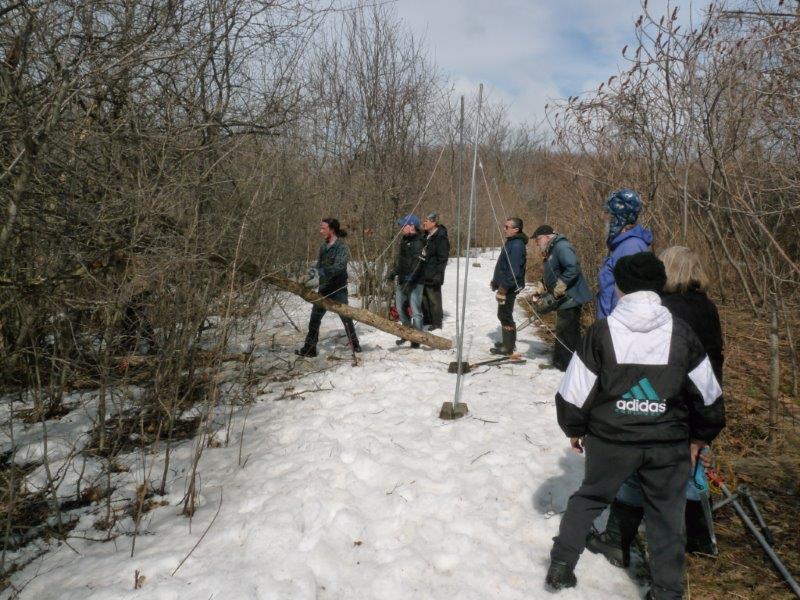
Volunteers helping with habitat management on a partly sunny but still snowbound day early this week (Photo by Marcel Gahbauer)
Week 4
| THIS WEEK | THIS SPRING | 2015 TOTAL | SITE TOTAL | |
|---|---|---|---|---|
| birds (and species) banded | 83 (14) | 83 (14) | 285 (21) | 52416 (114) |
| birds (and species) repeat | 18 (7) | 18 (7) | 50 (10) | 10560 (70) |
| birds (and species) return | 19 (6) | 19 (6) | 34 (9) | 1688 (38) |
| species observed | 56 | 67 | 68 | 209 |
| net hours | 362.8 | 362.8 | 397.8 | 89979.8 |
| birds banded / 100 net hours | 22.9 | 22.9 | 71.6 | 58.3 |
Banders-in-charge: Simon Duval, Gay Gruner
Assistants: Nicolas Bernier, Pascal Berthelot, Sue Bishop, Cindy Bouchard, Alexander Boyer, Luke Currin, David Davey, Jean Demers, Ashleigh Downing, Alison Hackney, Frédéric Hareau, Tom Kingsbury, Laura Torres, Lance Laviolette, Marcel Lebeau, Barbara MacDuff, Betsy McFarlane, Phillip Mercier, Ahmad Shah, Paul Shay, Jillian Slater, Clémence Soulard, Patricia Stotland, Elise Titman, Rodger Titman, Christiane Tremblay
Notes: Last week’s burst of migration was not sustained; the 56 species observed this week was the lowest count ever for week 4 of spring, and the cumulative total of 67 to this point is just barely ahead of the record low of 66 back in our first season, 2005. Nonetheless, there were 10 new sightings for the season this week: Common Loon, Turkey Vulture, Osprey, Red-shouldered and Broad-winged Hawks, Belted Kingfisher, Barn Swallow, Red-breasted Nuthatch, Ruby-crowned Kinglet, and Hermit Thrush.
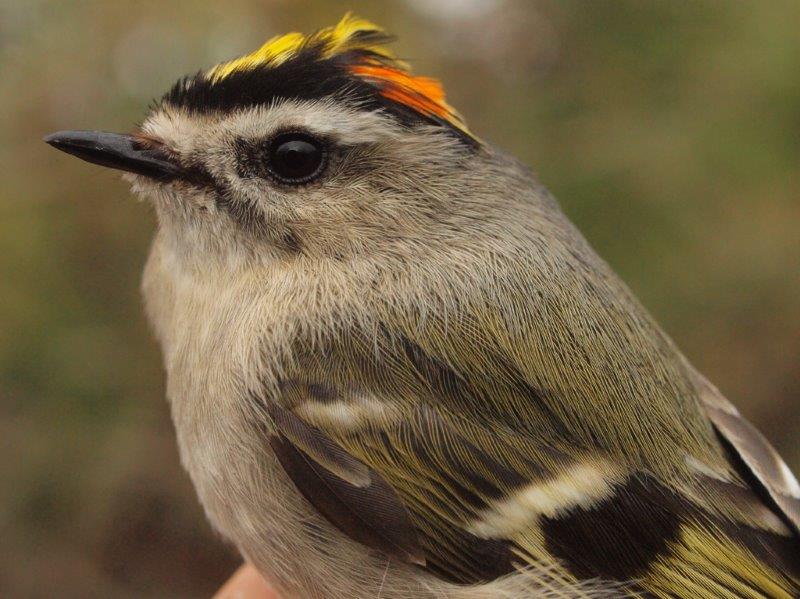
Golden-crowned Kinglets are a predictable highlight of the start of the spring banding season (Photo by Simon Duval)
Meanwhile, the banding program kicked off this week and in keeping with the lull in migration described above, results were decidedly modest. The number of birds banded this week was the fewest for week 4 since 2009, and only once (in 2007) were fewer species banded during this period. The number of returns (i.e., birds banded at MBO in previous years) was also below the range of 21-31 for this period over the past three years, but is close to the longer-term average.
| # individuals banded | mean # individuals observed daily |
|---|---|
| 1. Fox Sparrow (22) | 1. Canada Goose (80) [1] |
| 2. Slate-colored Junco (19) | 2. Red-winged Blackbird (49) [2] |
| 3. Ruby-crowned Kinglet (16) | 3. Slate-colored Junco (34) [-] |
| 4. American Robin (5) | 4. Ring-billed Gull (22) [-] |
| 5. Golden-crowned Kinglet (4) | 5. American Crow (16) [9] |
| 6. Brown Creeper (3) | 5. Fox Sparrow (16) [-] |
| 6. Song Sparrow (3) | 7. Song Sparrow (14) [7] |
| 8. Black-capped Chickadee (2) | 8. Black-capped Chickadee (11) [5] |
| 8. American Tree Sparrow (2) | 9. Tree Swallow (10) [-] |
| 8. White-throated Sparrow (2) 8. Red-winged Blackbird (2) |
10. Common Grackle (8) [4] |
Our first week of banding in spring 2015 produced an interesting result, with Fox Sparrow leading the way as it did in 2013, followed closely by Slate-colored Junco which was in modest numbers in 2013, but topped the list for week 4 in 2009 and 2011. Ruby-crowned Kinglet has been among the top three species banded in week 4 in seven of ten previous years, and again this spring. All the other species in the top ten were banded in much smaller numbers; of note, the two Red-winged Blackbirds banded ties the record low from 2005 and 2009.
As usual, Canada Goose remained the top species observed in week 4, although numbers were far smaller than usual, only above the record low of 48 in 2010. The count of Red-winged Blackbirds was also below average, although just slightly, and enough to retain the runner-up position. The biggest surprise this week was the influx of Slate-colored Juncos, which have only been among the top ten in week 4 in three previous years, and the highest mean daily count was 30 in 2011. Ring-billed Gull and American Crow numbers increased this week, and the large movement of Fox Sparrows was reflected in observations as well as banding (despite leading the list of birds banded, observations suggest as few as 20% of Fox Sparrows present were banded, although the percentage is likely a bit higher, assuming some stopover). The other notable result this week was Tree Swallow in 9th place, the first time in five years it has been abundant enough to make the top ten in week 4.
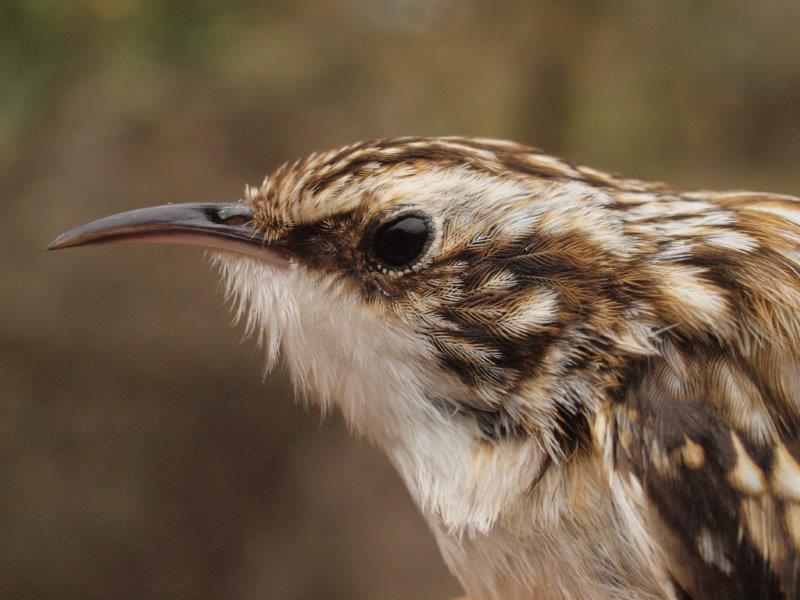
Always among the less common species banded at MBO, Brown Creeper is nonetheless one of the regular April migrants here (Photo by Simon Duval)
Week 5
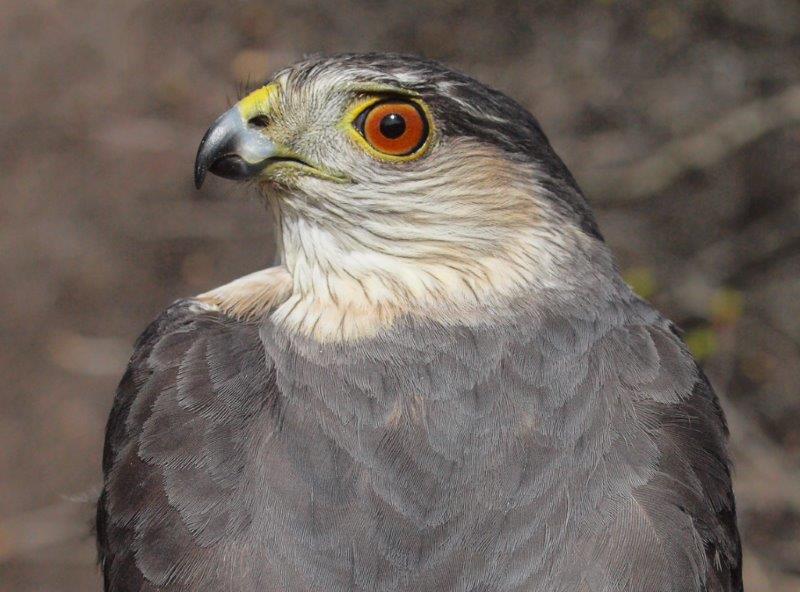
Our first raptor banded in 2015 was this nice after-second-year Sharp-shinned Hawk (Photo by Simon Duval)
| THIS WEEK | THIS SPRING | 2015 TOTAL | SITE TOTAL | |
|---|---|---|---|---|
| birds (and species) banded | 130 (14) | 213 (18) | 415 (25) | 52546 (114) |
| birds (and species) repeat | 29 (9) | 47 (9) | 79 (12) | 10589 (70) |
| birds (and species) return | 12 (9) | 31 (10) | 46 (12) | 1700 (38) |
| species observed | 64 | 78 | 79 | 209 |
| net hours | 485.0 | 847.8 | 882.8 | 90464.8 |
| birds banded / 100 net hours | 26.8 | 25.1 | 47.0 | 58.1 |
Banders-in-charge: Simon Duval, Gay Gruner
Assistants: Antoine Asselin, Johannie Bernard, Pascal Berthelot, Sue Bishop, Marc Boisvert, Cindy Bouchard, Marie-France Boudreault, Carl Bromwich, Luke Currin, David Davey, Jean Demers, Mégane Déziel, Alison Hackney, Frédéric Hareau, Tom Kingsbury, Laura Torres, Catherine Legault, Barbara MacDuff, Don MacDuff, Francine Marcoux, Betsy McFarlane, Madeleine McGreer, Phillip Mercier, Benoît Piquette, Catherine Russell, Ahmad Shah, Jillian Slater, Clémence Soulard, Patricia Stotland, Elise Titman, Rodger Titman, Christiane Tremblay
Notes: Although it felt like migration remained relatively modest overall this week, there were some big contrasts with last week, most notably the influx of Snow Geese passing by overhead, and the flocks of Cedar Waxwings right on site. Results from week 5 have varied widely over the years, and the 64 species observed this week were near the middle of the range of 55-75 from the past. Among them were another 11 new arrivals: Great Egret, Sharp-shinned Hawk, American Kestrel, Merlin, Great Horned Owl, Cliff Swallow, House Wren, Marsh Wren, Brown Thrasher, Yellow-rumped Warbler, and Savannah Sparrow.
Thanks in large part to the arrival en masse of Cedar Waxwings, the 130 birds banded this week was the second-highest ever for week 5, behind only last year’s count (which was fueled by an even higher count of waxwings).
| # individuals banded | mean # individuals observed daily |
|---|---|
| 1. Cedar Waxwing (49) [-] | 1. Greater Snow Goose (557) [-] |
| 2. Fox Sparrow (25) [1] | 2. Canada Goose (126) [1] |
| 3. Slate-colored Junco (23) [2] | 3. Red-winged Blackbird (46) [2] |
| 4. Ruby-crowned Kinglet (13) [3] | 4. Cedar Waxwing (31) [-] |
| 5. Red-winged Blackbird (9) [8] | 5. Ring-billed Gull (29) [4] |
| 6. White-throated Sparrow (2) [8] | 6. Slate-colored Junco (26) [3] |
| 6. Brown-headed Cowbird (2) [-] | 7. American Crow (23) [5] |
| 8. Sharp-shinned Hawk (1) [-] | 8. Fox Sparrow (15) [5] |
| 8. Northern Flicker (1) [-] | 9. Song Sparrow (14) [7] |
| 8. Black-capped Chickadee (1) [8] 8. Brown Creeper (1) [6] 8. American Robin (1) [4] 8. American Tree Sparrow (1) [8] 8. Swamp Sparrow (1) [-] |
10. Ruby-crowned Kinglet (13) [-] |
As noted above, Cedar Waxwings dominated banding in week 5 for the second year in a row, although not nearly as fully as last year (when we banded 147 of them, compared to the 8 American Robins in second place). Yet this is still only the fourth time in 11 years that Cedar Waxwing has been in the top ten at this point in spring – a most erratic pattern. From 2005 through 2010, Fox Sparrow was never in the top ten in week 5, but now it has been on the list for five years in a row, with this year’s count of 25 a significant increase over the previous record of 10 in 2013. The 23 Slate-colored Juncos banded this week was also a big jump from the old record of 14 in 2006. Rounding out the top five, Ruby-crowned Kinglet and Red-winged Blackbird numbers were closer to average. The remainder of the top ten (extended to a top fourteen due to a seven-way tie for 8th place) comprised birds in very small numbers (1-2 individuals each).
Among observations, Snow Goose displaced from Canada Goose from the top spot this week, with the third-largest spring flight we’ve observed at MBO, and the highest mean daily count for a week since 2007. Despite being bumped down, Canada Goose and Red-winged Blackbird numbers remained relatively similar to last week. Although not as dominant as last year at this time, Cedar Waxwing numbers were high enough to rank as the fourth most abundant species of the week, just ahead of Ring-billed Gull. Juncos, crows, and both Fox and Song Sparrows slid down in rank from last week, while the other new addition this week was Ruby-crowned Kinglet.
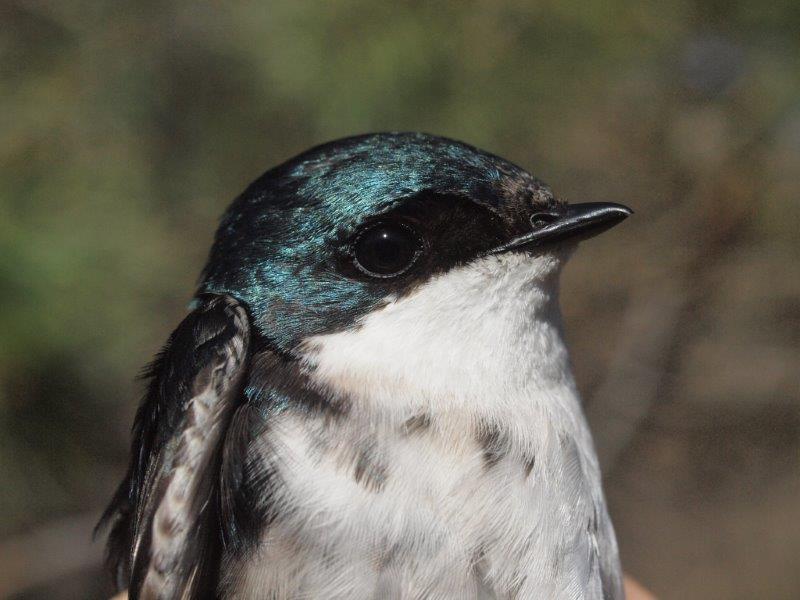
Although arriving somewhat later this spring, Tree Swallows are starting to return to MBO, and we hope at least some pairs will nest on site this year (Photo by Simon Duval)
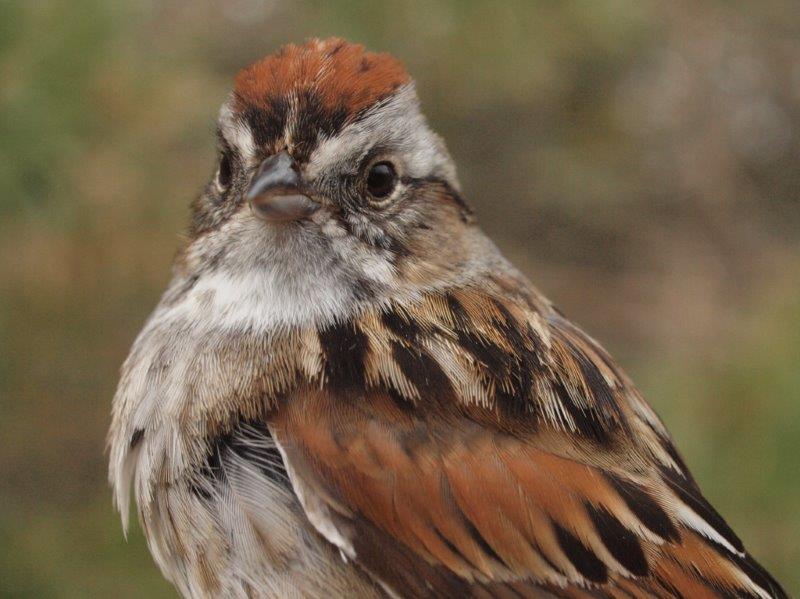
There are always a couple of resident Swamp Sparrows at MBO from spring through fall, as well as a number of additional migrants passing through; time will tell which category this one banded this week belongs to (Photo by Simon Duval)
Week 6
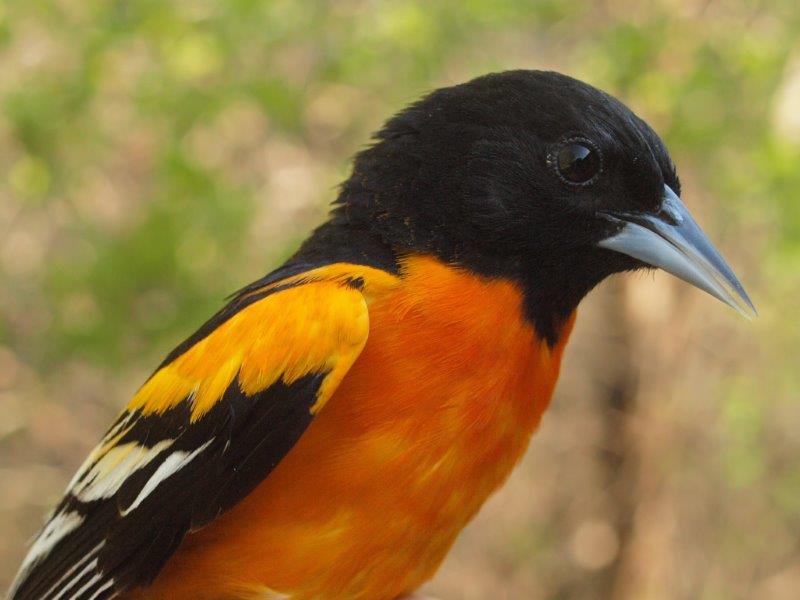
The final day of the week brought us this gorgeous after-second-year male Baltimore Oriole, our first of the year (Photo by Simon Duval)
| THIS WEEK | THIS SPRING | 2015 TOTAL | SITE TOTAL | |
|---|---|---|---|---|
| birds (and species) banded | 91 (23) | 304 (35) | 506 (40) | 52637 (114) |
| birds (and species) repeat | 7 (6) | 55 (12) | 87 (14) | 10597 (70) |
| birds (and species) return | 12 (8) | 43 (16) | 58 (18) | 1712 (38) |
| species observed | 91 | 111 | 112 | 209 |
| net hours | 560.0 | 1407.8 | 1442.8 | 91024.8 |
| birds banded / 100 net hours | 16.3 | 21.6 | 35.1 | 57.8 |
Banders-in-charge: Simon Duval, Gay Gruner
Assistants: Angelika Aleksieva, Nicolas Bernier, Pascal Berthelot, Alexander Boyer, Luke Currin, David Davey, Jean Demers, Ashleigh Downing, Barbara Frei, Alison Hackney, Jessica Head, Lisa Keelty, Barbara MacDuff, Francine Marcoux, Betsy McFarlane, Madeleine McGreer, Phillip Mercier, Benoît Piquette, Paul Shay, Jillian Slater, Clémence Soulard, Elise Titman, Rodger Titman
Notes: After a largely quiet April (aside from a couple of spurts of migration), the first full week of May marked a distinct transition, with a flood of species – the 91 observed this week was a record for week 6, two more than the previous record set in 2009, and well above the ten-year mean of 78 for this period. A whopping 33 of these were observed for the first time this season, one of the biggest single-week increases ever (exceeded only by the leap from 84 to 124 in week 7 last spring).
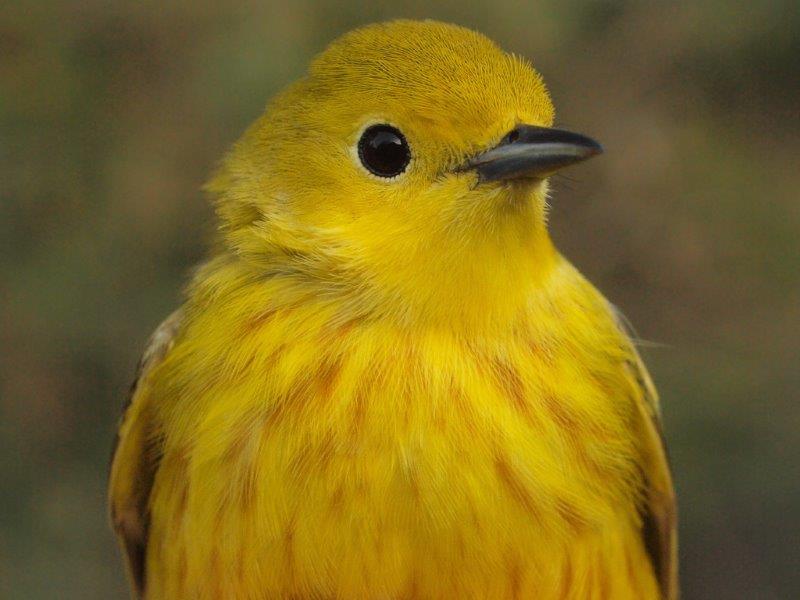
Yellow Warbler is the most common breeding warbler at MBO – will this early arrival hang around, or continue flying farther north? (Photo by Simon Duval)
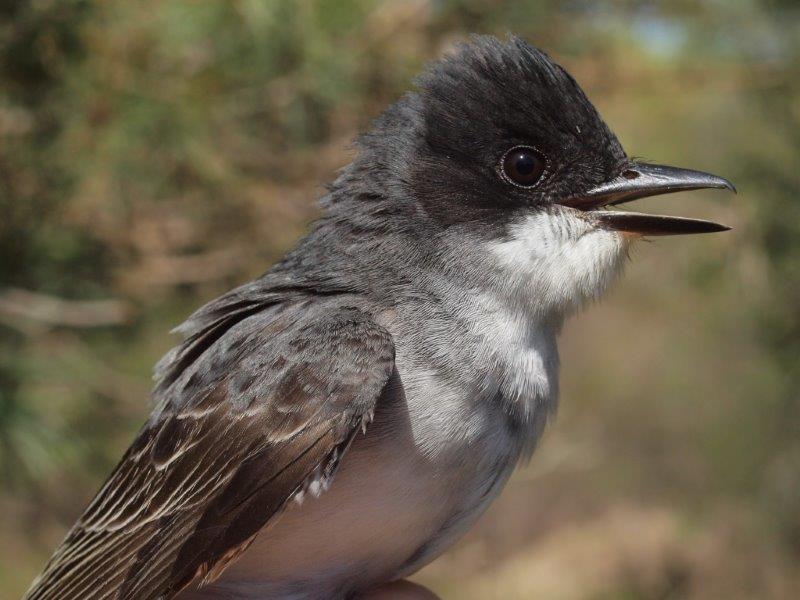
Similarly, we usually have at least one pair of Eastern Kingbirds breeding at MBO – we are curious whether this one will stay or continue migrating (Photo by Simon Duval)
On the other hand, the 91 individuals banded this week was a rather modest count, just below the ten-year mean of 95 for week 6 … despite full effort this week (i.e., no time lost to rain or wind), the capture rate remained remarkably low, with fewer than 10 birds banded on each of the first four days of the week. Diversity among birds banded was high though, with 23 species matching the previous high from 2006 and 2011.
| # individuals banded | mean # individuals observed daily |
|---|---|
| 1. Ruby-crowned Kinglet (24) [4] | 1. Canada Goose (211) [2] |
| 2. Red-winged Blackbird (17) [5] | 2. Red-winged Blackbird (58) [3] |
| 3. White-throated Sparrow (12) [6] | 3. Greater Snow Goose (32) [1] |
| 4. Common Grackle (5) [-] | 4. Ring-billed Gull (29) [5] |
| 5. American Robin (4) [8] | 5. Cliff Swallow (25) [-] |
| 5. American Goldfinch (4) [-] | 6. American Crow (23) [7] |
| 7. Yellow-rumped Warbler (3) [-] | 7. Black-capped Chickadee (13) [-] |
| 7. White-crowned Sparrow (3) [-] | 8. White-throated Sparrow (12) [-] |
| 9. Yellow-bellied Sapsucker (2) [-] | 9. Common Grackle (11) [-] |
| 9. Northern Waterthrush (2) [-] 9. Nashville Warbler (2) [-] 9. Yellow Warbler (2) [-] |
10. Song Sparrow (11) [9] |
The banding results this week showed a dramatic shift, with none of last week’s top three (Cedar Waxwing, Fox Sparrow, Slate-colored Junco) hanging around. Instead, last week’s 4-5-6 species (Ruby-crowned Kinglet, Red-winged Blackbird, White-throated Sparrow) each shifted up three places to become the new top three. Taking into account the four-way tie for 9th place this week, there were an unusually high 8 new additions to this week’s top ten, with Common Grackle and American Goldfinch the most numerous of the bunch, and four warblers among the rest.
The same three species dominated observations this week as last, although the order shuffled, with Snow Goose dropping from top spot to third place. As among the birds banded, there was a fair amount of turnover in birds observed, with Cliff Swallows and White-throated Sparrows returning from the south, Common Grackle numbers growing, and Black-capped Chickadee numbers rebounding.
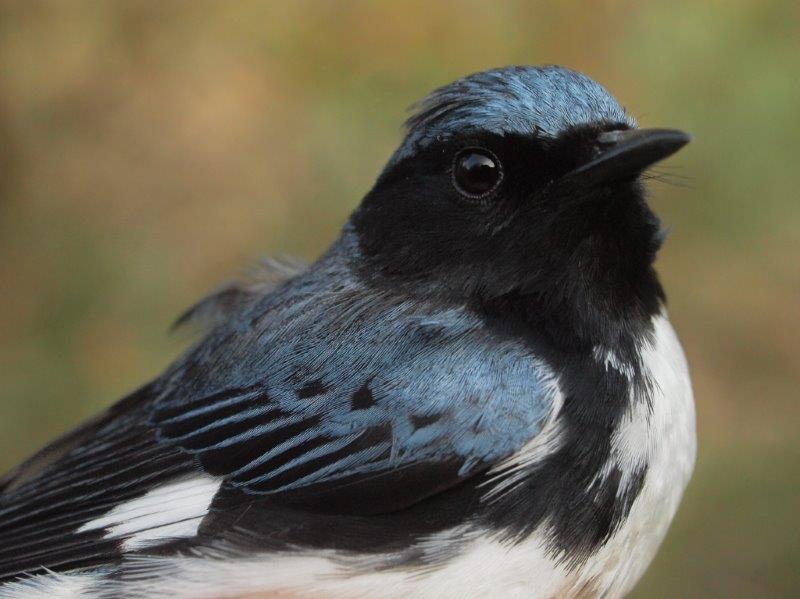
Although a reasonably common bird at MBO in fall, Black-throated Blue Warblers are rather scarce in spring, with no more than 3 banded in any previous season; only one other has been banded as early as week 6 (Photo by Simon Duval)

Similarly, Palm Warbler is much more common at MBO in fall than spring; this Western Palm Warbler banded on May 5 was only the 7th banded in 11 years of spring migration monitoring (Photo by Simon Duval)
Week 7

Among the rarest birds banded at MBO in week 7 was this Northern Parula, only the second one banded here in spring since 2011 (Photo by Simon Duval)
| THIS WEEK | THIS SPRING | 2015 TOTAL | SITE TOTAL | |
|---|---|---|---|---|
| birds (and species) banded | 273 (48) | 577 (61) | 779 (65) | 52910 (114) |
| birds (and species) repeat | 40 (17) | 95 (26) | 127 (28) | 10637 (70) |
| birds (and species) return | 23 (10) | 66 (20) | 81 (21) | 1735 (38) |
| species observed | 96 | 132 | 133 | 209 |
| net hours | 437.5 | 1845.3 | 1880.3 | 91462.3 |
| birds banded / 100 net hours | 62.4 | 31.3 | 41.4 | 57.8 |
Banders-in-charge: Simon Duval, Gay Gruner
Assistants: Antoine Asselin, Nicolas Bernier, Pascal Berthelot, Cindy Bouchard, Marie-France Boudreault, Alexander Boyer, Luke Currin, David Davey, Mégane Déziel, Ashleigh Downing, Barbara Frei, Alison Hackney, Tom Kingsbury, Marcel Lebeau, Véronique Lemay, Barbara MacDuff, Francine Marcoux, Madeleine McGreer, Catherine Russell, Jillian Slater, Patricia Stotland, Elise Titman, Rodger Titman, Christiane Tremblay, Jesse White
Notes: After being teased last week with high diversity but low banding rates, this week both came together impressively. The 96 species observed this week was just short of last year’s record of 98 for week 7, and with a remarkable additional 21 “new” species this week on top of last week’s 33 fresh arrivals, the total for the season is up to 132, ahead of the previous record pace of 129 at this point in 2012, and far above the ten-year man of 120.
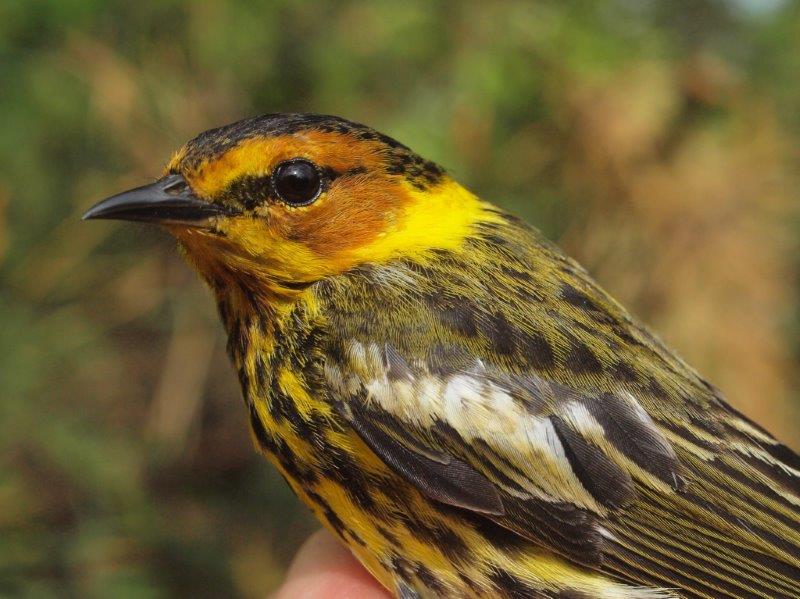
We have only once previously banded more than a single Cape May Warbler in a week in spring (in 2012), so it was a pleasant surprise to be able to compare the male (above) and female (below) banded this week (Photo by Simon Duval)
Meanwhile, the 48 species banded this week is a new spring record, a big jump up from the previous high of 44 during week 8 of 2009. The 273 birds banded was also far above average, although around 10% short of last year’s record of 305.
|
# individuals banded |
mean # individuals observed daily |
| 1. Tennessee Warbler (36) [-] | 1. Red-winged Blackbird (43) [2] |
| 2. Magnolia Warbler (31) [-] | 2. Canada Goose (25) [1] |
| 3. Yellow-rumped Warbler (26) [7] | 3. Tennessee Warbler (22) [-] |
| 4. White-throated Sparrow (22) [3] | 4. American Crow (17) [6] |
| 5. Red-winged Blackbird (18) [2] | 5. Ring-billed Gull (16) [4] |
| 6. Ruby-crowned Kinglet (13) [1] | 6. White-throated Sparrow (16) [8] |
| 7. Nashville Warbler (12) [9] | 7. Yellow-rumped Warbler (14) [-] |
| 7. Yellow Warbler (12) [9] | 8. Cliff Swallow (13) [5] |
| 9. Common Yellowthroat (8) [-] | 9. Magnolia Warbler (12) [-] |
| 10. Northern Waterthrush (7) [9] | 10. Black-capped Chickadee (11) [7] |
Week 7 is typically when warblers begin to show up at MBO in good numbers, and this year they were particularly prominent, with a record high 7 species among the top ten banded (the previous high was 6 in 2012, but the 10-year mean is 3.6). Leading the way was an unusually early movement of Tennessee Warblers – despite being among our most abundant spring warblers overall, it has only appeared in the top ten in week 7 once previously (in 2012). Close behind was Magnolia Warbler, which also is usually just beginning to arrive at this point in the season (mean number banded in week 7 to date 4.2, and previous record 19 in 2014). Yellow-rumped Warbler rounded out the top three, with relatively typical numbers. Unlike most of the warblers, White-throated Sparrows were late, with this being the first time since 2008 that their migration peaked in week 7. Red-winged Blackbird and Ruby-crowned Kinglet dropped to the middle of the top ten this week, but in relatively average numbers compared to the past ten years. Among the four warblers rounding out the bottom of the top ten, all were in above average numbers for week 7, including a record count for Nashville Warbler.
For the first time this spring, the species most observed over the course of the week was not a goose, as the Canada Goose numbers dropped sharply (to the lowest numbers for week 7 since 2007). Red-winged Blackbird counts remained steady, and took over top spot. The unprecedented early mass movement of Tennessee Warblers (over 200 observed this week) was reflected by it cracking the top three; Magnolia Warbler also was in the top ten for the first time ever in week 7. As noted with respect to the banding totals, White-throated Sparrows were unusually common for this late in spring. The other species in the top ten this week were largely the usual suspects in fairly typical numbers.

This Rusty Blackbird was only the 15th ever banded at MBO, making it overall the rarest bird of the week – however, this is the third time in the past four years that at least one has been banded during the Spring Migration Monitoring Program (Photo by Simon Duval)
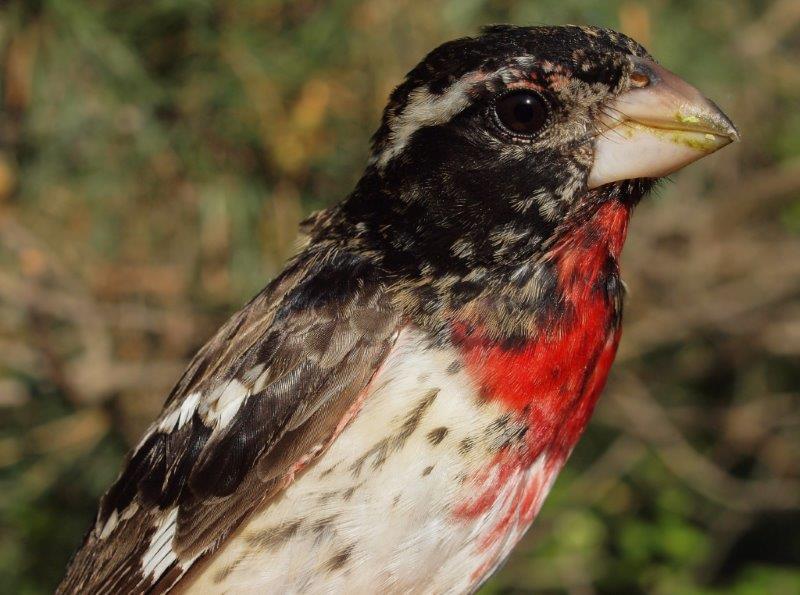
Some species are much easier to age and sex in spring than others – the mottled reddish throat and breast of this Rose-breasted Grosbeak, combined with the extensive patches of brown on the back and wings clearly identify this as a second-year male (Photo by Simon Duval)
Week 8
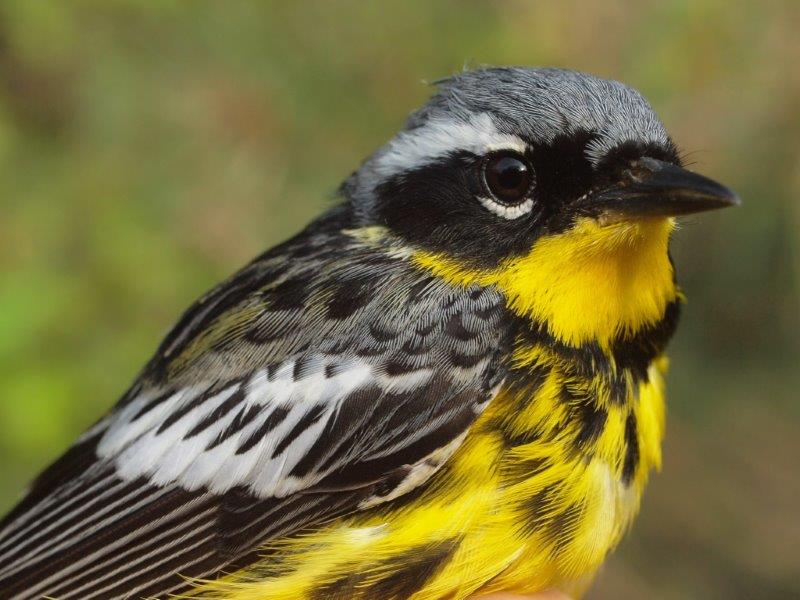
Magnolia Warbler, one of the three warbler species that dominated this week’s banding results (Photo by Simon Duval)
| THIS WEEK | THIS SPRING | 2015 TOTAL | SITE TOTAL | |
|---|---|---|---|---|
| birds (and species) banded | 373 (43) | 950 (66) | 1152 (70) | 53283 (114) |
| birds (and species) repeat | 75 (21) | 170 (33) | 202 (35) | 10712 (70) |
| birds (and species) return | 25 (15) | 91 (26) | 106 (27) | 1760 (38) |
| species observed | 101 | 141 | 142 | 210 |
| net hours | 556.0 | 2401.3 | 2436.3 | 92018.3 |
| birds banded / 100 net hours | 67.1 | 39.6 | 47.3 | 57.9 |
Banders-in-charge: Simon Duval, Gay Gruner
Assistants: Nicolas Bernier, Pascal Berthelot, Cindy Bouchard, Marie-France Boudreault, Claude Cloutier, Luke Currin, David Davey, Ashleigh Downing, Alison Hackney, Marcel Lebeau, Barbara MacDuff, Don MacDuff, Francine Marcoux, Betsy McFarlane, Madeleine McGreer, Phillip Mercier, Guillaume Raymond, Jillian Slater, Patricia Stotland, Elise Titman, Rodger Titman, Christiane Tremblay, Jesse White
Notes: After an uncharacteristically busy week 7, including several species that showed up earlier than usual, we were not expecting week 8 to reach even greater heights – but it did! The 101 species observed this week marked only the fourth time in MBO’s history that over 100 were recorded in a single week, and with yet another 9 species added to the spring 2015 list this week, the season total of 141 remains ahead of the previous record of pace set in 2006 and tied in 2009.
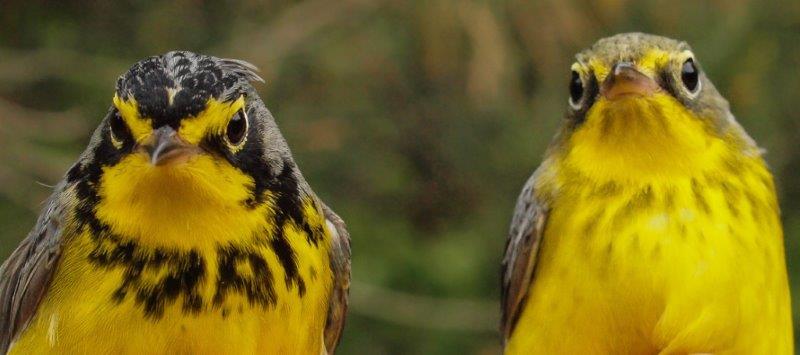
MBO is fortunate to see relatively good numbers of Canada Warblers, a Threatened species under Canada’s Species at Risk Act. On one occasion this week we had a nice opportunity to compare a male (left) and female (right) (Photo by Simon Duval)
The most notable of this week’s additions was a White-eyed Vireo observed on two consecutive mornings, becoming the 211th species observed at MBO. The other newcomers were a mix of late-season migrants (Black-billed Cuckoo, Eastern Wood-Pewee, Yellow-bellied Flycatcher, Alder Flycatcher, Gray-cheeked Thrush, Mourning Warbler, and Blackpoll Warbler) and uncommon to rare species (Peregrine Falcon, Scarlet Tanager). Meanwhile, the 373 birds banded was a new single-week record for spring, and brought our season total to 950, just shy of last year’s record pace (964 at this point in the season).
| # individuals banded | mean # individuals observed daily |
|---|---|
| 1. Tennessee Warbler (60) [1] | 1. Red-winged Blackbird (37) [1] |
| 2. Magnolia Warbler (46) [2] | 2. Ring-billed Gull (33) [5] |
| 3. Yellow-rumped Warbler (40) [3] | 3. Cliff Swallow (24) [8] |
| 4. Northern Waterthrush (23) [10] | 4. Tennessee Warbler (21) [3] |
| 5. Wilson’s Warbler (21) [-] | 5. American Crow (21) [4] |
| 6. American Goldfinch (20) [-] | 6. Yellow-rumped Warbler (12) [7] |
| 7. American Redstart (17) [-] | 7. Magnolia Warbler (11) [9] |
| 8. Traill’s Flycatcher (12) [-] | 8. American Goldfinch (10) [-] |
| 8. Yellow Warbler (12) [7] | 9. Yellow Warbler (10) [-] |
| 10. Least Flycatcher (8) [-] 10. Chestnut-sided Warbler (8) [-] |
10. Baltimore Oriole (10) [-] |
Tennessee, Magnolia, and Yellow-rumped Warblers all held onto their top three rankings for a second week in a row on the list of species banded. This marks the third time that Tennessee Warbler has dominated week 8 (along with 2009 and 2012), while Magnolia was the top species the past two years, and Yellow-rumped in 2011. But while these three species are routinely common in week 8, all were in above average numbers this year, with Tennessee setting a new record. Another five warbler species also cracked the top ten this week, led by 23 Northern Waterthrush (tying the week 8 record set in 2013), and 21 Wilson’s Warblers (unusually early). Most notable perhaps though was American Redstart, with the 17 individuals banded this week exceeding the spring total from all previous years except 2012, when 19 were banded over the course of the season (mostly in week 9). Similarly, the 8 Chesnut-sided Warblers banded marks a single-week record for spring, and is just shy of the season record of 9 set last year. Also of note for being early is the total of 12 Traill’s Flycatchers, given a previous high of just 3 in week 8.
Over the past ten years, Ring-billed Gull and Red-winged Blackbird have each been the most abundant species in week 8 five times; this year the blackbird was slightly more numerous. Cliff Swallow numbers nearly doubled this week compared to last, vaulting them into third place for the first time since 2009-2010. Corresponding to the record number banded, the mean daily count of Tennessee Warblers was higher than any previous week 8. New additions to the top ten this week were Yellow Warbler, American Goldfinch, and Baltimore Oriole, which made the list for the fifth year in a row.
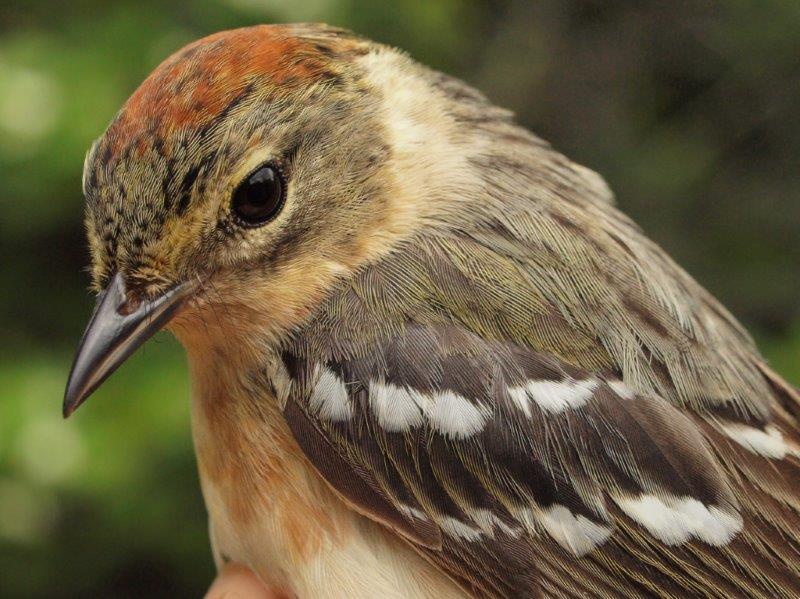
Among the less common species banded this week were this Gray-cheeked Thrush (above), just the 7th one ever banded at MBO in spring, and female Bay-breasted Warbler (below), only the 13th of its kind banded at MBO in 11 spring seasons (Photos by Simon Duval)
Week 9
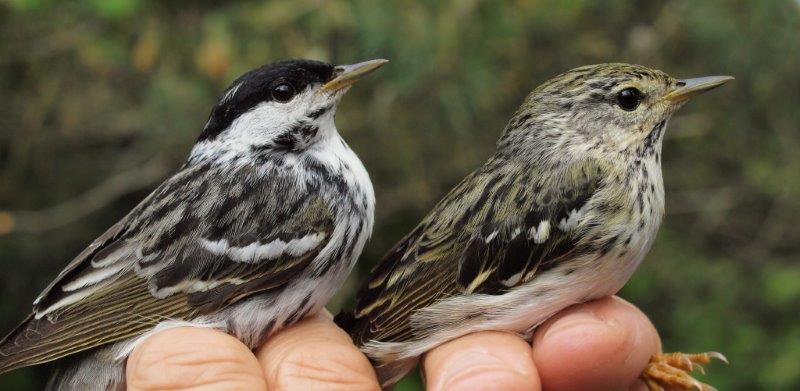
A sure sign that spring migration is approaching its end is the arrival of Blackpoll Warblers, such as this male (left) and female (right) banded at MBO this week (Photo by Simon Duval)
| THIS WEEK | THIS SPRING | 2015 TOTAL | SITE TOTAL | |
|---|---|---|---|---|
| birds (and species) banded | 154 (32) | 1104 (68) | 1306 (71) | 53437 (114) |
| birds (and species) repeat | 60 (20) | 230 (36) | 262 (38) | 10772 (70) |
| birds (and species) return | 8 (6) | 99 (26) | 114 (27) | 1768 (38) |
| species observed | 91 | 146 | 147 | 209 |
| net hours | 548.8 | 2950.1 | 2985.1 | 92567.1 |
| birds banded / 100 net hours | 28.1 | 37.4 | 43.8 | 57.7 |
Banders-in-charge: Simon Duval, Gay Gruner
Assistants: Johannie Bernard, Pascal Berthelot, Marc Boisvert, Cindy Bouchard, Claude Cloutier, Luke Currin, David Davey, Leah den Besten, Mégane Déziel, Ashleigh Downing, Alison Hackney, Marcel Lebeau, Barbara MacDuff, Betsy McFarlane, Madeleine McGreer, Phillip Mercier, Patricia Stotland, Christiane Tremblay, Jesse White
Notes: In some years, spring migration peaks in week 8; in others we get our biggest numbers in week 9. Considering that this year many species showed up in larger than usual numbers already in week 7, it wasn’t surprising to see the numbers this week taper off from last week’s highs. However, diversity remained good, with 91 species observed (perfectly matching the ten-year mean for week 9), and 32 banded (also exactly average over the long term).
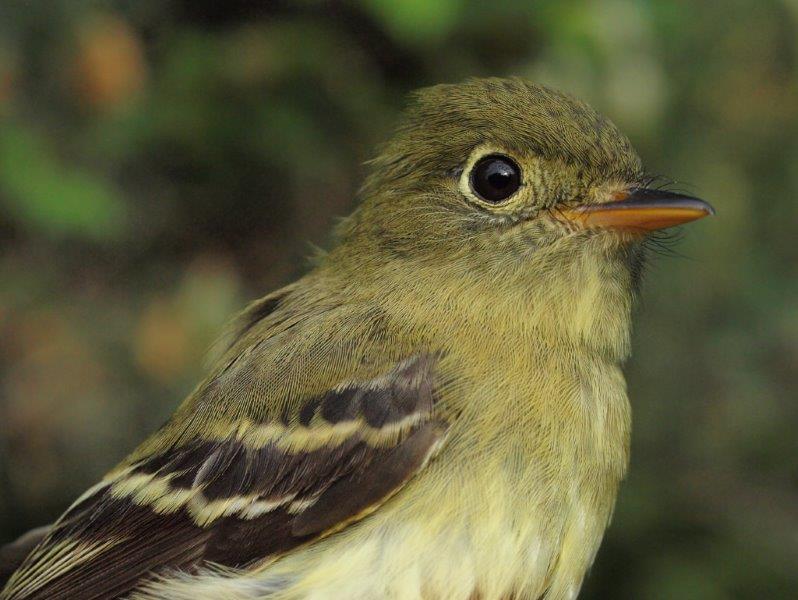
Yellow-bellied Flycatchers are always a treat to band in spring, with an average of only 1.3 per year over the first decade of MBO’s operations (Photo by Simon Duval)
The number of birds banded dropped sharply from last week, and was actually a bit below normal for this period (154 this week vs. ten-year mean of 173). Not surprisingly, there were relatively few new species at this point of the season, but we did observe our first Chimney Swift, Willow Flycatcher, Philadelphia Vireo, Clay-colored Sparrow, and Field Sparrow of 2015, and also banded our first Yellow-bellied Flycatcher, Willow Flycatcher, and European Starling of the season.
| # individuals banded | mean # individuals observed daily |
|---|---|
| 1. Wilson’s Warbler (15) [5] | 1. Red-winged Blackbird (33) [1] |
| 2. Tennessee Warbler (14) [1] | 2. Ring-billed Gull (24) [2] |
| 3. Traill’s Flycatcher (12) [8] | 3. American Crow (18) [5] |
| 4. American Goldfinch (11) [6] | 4. Cliff Swallow (16) [3] |
| 5. Magnolia Warbler (10) [2] | 5. American Goldfinch (13) [8] |
| 6. Northern Waterthrush (9) [4] | 6. Common Grackle (11) [-] |
| 6. Common Yellowthroat (9) [-] | 7. Cedar Waxwing (10) [-] |
| 6. American Redstart (9) [7] | 8. Baltimore Oriole (9) [10] |
| 9. Yellow Warbler (7) [8] | 9. Yellow Warbler (8) [9] |
| 10. Gray Catbird (6) [-] 10. Blackpoll Warbler (6) [-] |
10. Common Yellowthroat (8) [-] |
Numbers banded this week were substantially down from week 8, with relatively little separation among the top ten, and for the second week in a row the list includes 8 warbler species. Wilson’s Warbler took the top spot for the first time ever, in any season, but was just ahead of the tail end of this year’s strong migration of Tennessee Warblers. A dozen Traill’s Flycatchers were banded for the second week in a row, and continuing the trend of strong week 9 counts in recent years (mean of 15 from 2011-2015, compared to 3.5 from 2005-2010). This week’s 9 American Redstarts followed up on last week’s unprecedented spring movement, and have resulted in a new spring season record.
For the second week in a row, the most abundant species at MBO was Red-winged Blackbird, followed by Ring-billed Gull; again this matches the historical pattern of these two species dominating week 9. American Crow and Cliff Swallow remained in the top five as well, but last week’s #4 species (Tennessee Warbler) dropped off the list this week, reflecting the early shift in migration this year (last year the daily mean count of Tennessee Warbler during week 9 was 28). Reflecting the late part of the season overall, most of the rest of the top ten comprised local breeders – Yellow Warbler, Common Yellowthroat, Common Grackle, Baltimore Oriole (although some of the individuals observed may well have been migrants passing through, especially among the orioles).
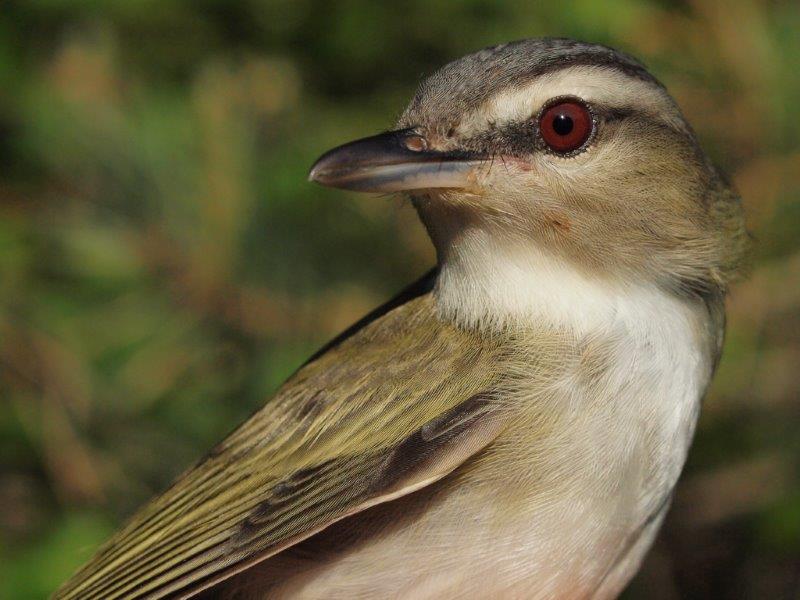
Although common at MBO throughout much of fall migration, Red-eyed Vireos are late spring arrivals, and are therefore usually banded in small numbers each year; the four banded this week tied a single-week high for the season reached twice previously (Photo by Simon Duval)
Week 10
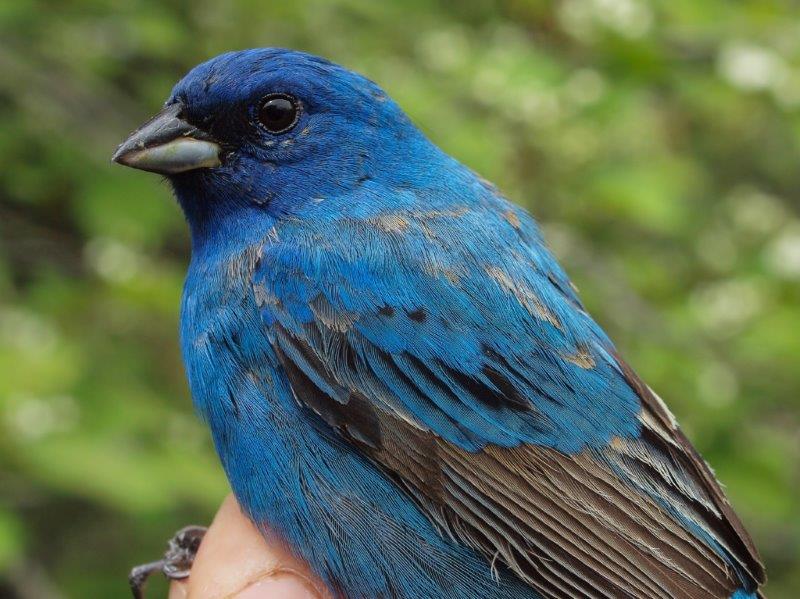
This second-year male Indigo Bunting may hang around MBO to breed this summer (Photo by Simon Duval)
| THIS WEEK | THIS SPRING | 2015 TOTAL | SITE TOTAL | |
|---|---|---|---|---|
| birds (and species) banded | 13 (10) | 1117 (69) | 1317 (72) | 53450 (114) |
| birds (and species) repeat | 4 (4) | 234 (37) | 266 (39) | 10776 (70) |
| birds (and species) return | — | 99 (26) | 114 (27) | 1768 (38) |
| species observed | 69 | 147 | 148 | 209 |
| net hours | 85.2 | 3035.3 | 3070.3 | 92652.3 |
| birds banded / 100 net hours | 15.3 | 36.8 | 43.0 | 57.7 |
Banders-in-charge: Simon Duval, Gay Gruner
Assistants: Johannie Bernard, Marc Boisvert, Marie-France Boudreault, Geneviève Brodeur, David Davey, Alison Hackney, Laura Torres, Barbara MacDuff, Betsy McFarlane, Madeleine McGreer, Phillip Mercier, Éric Rémillard, Elise Titman, Rodger Titman
Notes: Following a terrific middle of May, migration started to taper off noticeably last week, and here in our final week of spring the season ended with some rather meager results. The 13 birds banded during this period was far lower than in any previous year, although that was largely a consequence of rain limiting efforts. Despite that, the season total of 1117 is far above the long-term average, and only behind last year’s record of 1356; the 69 species banded matches last year’s record. Meanwhile the 69 species observed during the final week of spring was also well below average, but included one more new addition to the spring list (Purple Martin), bringing the season total to 147, second only to the 149 observed in 2006.
| # individuals banded | mean # individuals observed daily |
|---|---|
| 1. Blackpoll Warbler (3) [10] | 1. Red-winged Blackbird (30) [1] |
| 2. Cedar Waxwing (2) [-] | 2. American Crow (13) [3] |
| 3. Northern Waterthrush (1) [6] | 3. Cedar Waxwing (10) [7] |
| 3. Ovenbird (1) [-] | 4. American Goldfinch (9) [5] |
| 3. Tennessee Warbler (1) [2] | 5. Cliff Swallow (8) [4] |
| 3. Mourning Warbler (1) [-] | 6. Common Yellowthroat (6) [10] |
| 3. Chestnut-sided Warbler (1) [-] | 7. Yellow Warbler (6) [9] |
| 3. Yellow Warbler (1) [9] | 8. Baltimore Oriole (5) [8] |
| 3. Lincoln’s Sparrow (1) [-] | 9. Tree Swallow (5) [-] |
| 3. Baltimore Oriole (1) [-] | 10. Northern Cardinal (5) [-] |
Weather severely constrained banding effort during our final week (which to begin with only includes three days of banding, given that beyond June 1 the local breeders dominate). As such, the ranking of species this week is not that meaningful, although it is interesting to note that Blackpoll Warbler (#1) has topped the list for week 10 twice before (in 2007 and 2009), and Cedar Waxwing (#2) has been the top species in six of ten previous years.
For the ninth time in 11 years, Red-winged Blackbird was the most numerous species observed during our final week of spring. Last year was one of the exceptions, with Ring-billed Gull dominating instead – but this year, despite being the second-most common species the past couple of weeks, gulls were scarce and did not even crack the top ten. Instead, American Crow, Cedar Waxwing, and American Goldfinch shifted up, with Cliff Swallow hanging on in the top five as well. The bottom half of the top ten includes three of the same species as last week (Common Yellowthroat, Yellow Warbler, Baltimore Oriole), but Tree Swallow and Northern Cardinal replaced Ring-billed Gull and Common Grackle.
With another successful spring season complete, we would like to take this opportunity to thank our many dedicated volunteers who woke up early each morning to help us run the program – without their help we could not maintain our standard operations! As usual, we will now scale back efforts for summer, completing our occasional visits for the MAPS (Monitoring Avian Productivity and Survivorship) program, and then resuming daily coverage for fall migration on August 1.
